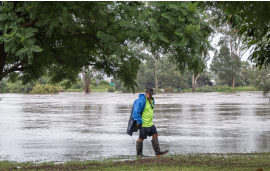A tsunami is a series of large, powerful waves that can approach the shore as fast as 160 kilometres per hour. These waves can cause widespread damage when they come ashore.
Tsunamis are most often caused by earthquakes, but can also be caused by landslides and volcanic eruptions. A warning sign that a tsunami is coming is a rapidly falling or rising tide.
Risk of tsunami on the North Shore: Low
A study by the SFU Centre for Natural Hazard Research found that North and West Vancouver are at low risk for a tsunami.
You can view the report at North Shore libraries, at our office, or download it here:
How to prepare
Emergency Management BC has divided the province into five zones to help notify you of a tsunami. To be prepared, first find out what zone you are in.
Then put together an emergency kit so you can survive on your own for a minimum of 72 hours.
What to do during a tsunami
- If there is an earthquake, grab your emergency kit after the shaking stops and move to high ground or inland 3m to 9m (10 ft to 30 ft) above tide level.
- Listen to local media and follow instructions from emergency officials.
- Stay away from the beach. Never go down to the water to watch a tsunami come in.
- Stay away from debris in water. It can be dangerous to people and pets.
- Once you are in a safe place, stay there until an “all clear” is given. The largest wave is usually the third or fourth. There can be 10 minutes to more than an hour between waves.
Get notified of a tsunami
- Sign up for Alertable emergency notifications
- EmergencyInfoBC alerts
- Intergovernmental Oceanographic Commission notifications
- Look up warnings on the US Tsunami Warning Centers website






